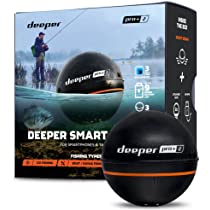What are the best fish finders under $400? This article answers this lengthily so that you get the best of the best. A fish finder is a gadget that produces sonar waves reflected off underwater objects and then converted into images on a screen. This way, you can pinpoint fish underwater. If you are a fisher looking for a fish finder that doesn’t cost a dime, you are in the right place. Today’s article explores various options that are suitable for you. You can be certain that you are getting your penny’s worth as the best fish finders host unsullied features. Gone will be the days when you go back home empty-handed. Now, let’s dig deeper into the best fish finders under $400.
Best Fish Finders Under $400
1)Garmin Striker Vivid 7cv
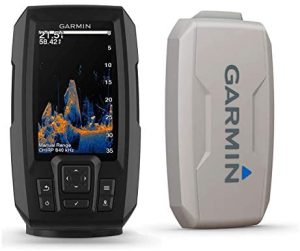
The Garmin Striker Vivid 7cv kicks off our list of the best fish finder under $400. Along with its approachable price, the finder is easy to use and is compactly made. This makes it perfect for small boats.
Improved vivid scanning sonar color palettes on a 7″ color fish finder make distinguishing between fish and structure simple. You can view fish and underwater structures thanks to the bundled transducer’s CHIRP ClearVü scanning sonar and classic sonar capabilities.
The finder is, in addition, Wi-Fi enabled. This enables you to connect your compatible smartphone to the ActiveCaptain app for even more functionality.
Besides that, With the built-in GPS, you can mark waypoints, design routes, and check your boat’s speed. This is, without a doubt, a fish finder that delivers an unforgettable fishing experience.
Features
- Incorporates inbuilt Quickdraw Contours mapping
- 7-inch display
- Wi-Fi connectivity
- Built-in GPS for more convenience
- GT20 transducer
- Seven color options for optimal contrast and clarity
Pros
- Easy to use
- Compact design
- Great quality
Cons
- The installation process is tricky for some
2) Humminbird Helix 5 CHIRP DI Fish Fender
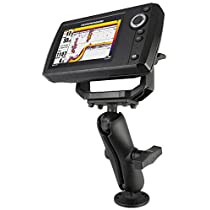
With the Humminbird Helix 5 CHIRP DI Fish Fender, high-quality features and performance are yours. Many fishers love it as it is effortless to use and comes with the Navionics App that offers a number of data plans.
DualBeam lets you choose between a wide beam for a larger search area and a small beam for more accuracy. You can combine the two using DualBeam Plus to get even more detail.
It features a 5-inch widescreen LED-backlit display and has built-in map coverage for over 21,000 lakes and water bodies.
It boasts a digital CHIRP that produces more precise and detailed returns of structure, fish, and the bottom. Additionally, Down Imaging is included for a clearer picture of your boat’s bottom. Side Imaging, on the other hand, helps you discover the world beneath the surface from a side-to-side perspective that is unmatched.
Features
- 5-inch display
- CHIRP digital sonar
- Down and Side Imaging
- Comes with the Navionics app
Pros
- Large screen
- User-friendly interface
- Boasts all essential features
Cons
- The screen could be brighter
3) Garmin Striker 4 Fish Finder
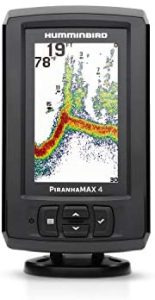
Garmin Striker 4 Fish Finder is another perfect option for budget-conscious anglers. It is ideal for novel fishers as well. The Striker 4 has a built-in flasher and is fantastic for vertical jigging or ice fishing. The viewing area measures 1.9 inches in width by 2.9 inches in height, and the screen is comparable to an iPhone 8 Plus.
It is a top-tier fish finder that offers Clear Vu Scanning Sonar. It can show pictures with accurate representations of the structures, objects, and fish in the water around your boat.
A continuous sweep of frequencies sent by chirp sonar gives a greater range of information, creating targets that are more clearly separated from one another and crisper fish arches.
Regarding operation, the installation process is a breeze. Once you are done, using it is also hitch-free. The waypoint map comes in handy to view, mark, and navigate places like brush piles, stumps, and docks.
Features
- Built-in flasher
- IPX7 water resistance rating
- Clear Vu scanning sonar
- Waypoint map
- Perfect for ice fishing and vertical jigging
Pros
- Easy installation process
- Decent screen
- Powerful Sonar capabilities
- Great quality
Cons
- Not waterproof
4)Garmin Striker Plus 5cv
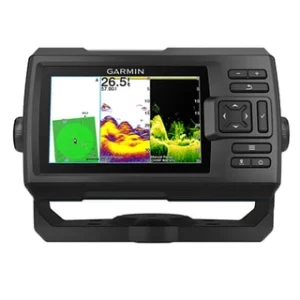
Another fish finder from Garmin is the Striker Plus 5cv. This fish finder is simple to use in all fishing environments with its bright, sunlight-readable 5″ display and user-friendly user interface. Additionally, the larger display allows you to see better what’s going on below the boat. It is ruggedly built to withstand the unavoidable tempestuous conditions in the fishing world.
For a virtually photographic-quality wide image of what passes under your boat, the unit combines Garmin CHIRP technology with ClearVü scanning sonar. Structures, underwater objects, and fish are all easily visible. This transducer will help you catch more fish when used in conjunction with Garmin CHIRP conventional sonar for outstanding target separation.
Furthermore, it comes with built-in Garmin QuickDraw Contours Mapping software, which enables you to generate and store maps with 1′ contours for up to 2 million acres.
If you wish to mark waypoints, make routes, or view boat speed, this fish finder also contains a built-in GPS. All these impressive features solidify the finder’s name as one of the best under $400.
Features
- 5-inch display that is well-readable even in bright sunlight
- Built-in GPS
- Garmin Quickdraw contours
- Easy-to-operate user interface
- A transducer for the integrated Garmin CHIRP traditional sonar as well as the CHIRP clearer scanning sonar
Pros
- High-grade construction
- Survives regardless of the environment
- Crisp views of underneath objects
Cons
- Uploading locations is tricky because there is no included download cable.
5)Deeper PRO + Smart Sonar
Your shore fishing skills will change for the better with the Deeper PRO + Smart Sonar. Besides being ideal for shore fishing, this finder also works perfectly for boat and kayak fishing. It is a no-frill finder as you just need to cast the sonar into the water, await a response, and then reposition your fishing line to point in the fish’s direction. Advanced sonar technology can read the depth and water’s temperature after being tossed into the water.
You will appreciate the portability of this unit. Moreover, it resembles a tennis ball that is small sized.
Your smartphone and the transducer are linked together over Wi-Fi. You can anticipate a faster data transfer rate as a result.
The Deeper PRO+ Smart Sonar scans fifteen times in a second. The transducer can also scan a wider area in addition to a narrower area. It can scan 260 feet deep and has a 330 feet casting range.
Features
- Looks like a small tennis ball
- Wi-Fi connects the transducer to your smartphone
- Ideal for multiple uses
- Allows you to switch between wide and narrow scan
- 330 feet casting range
- Wi-Fi enabled
Pros
- Easy to use
- Compact size
- Gives you free access to Lakebook
- Ideal for all fishing styles
Cons
- No protective cover and vital accessories
6)Humminbird ICE-45
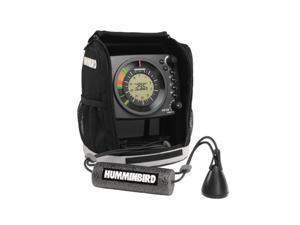
For those who want to keep ice fishing as simple as possible, the Humminbird ICE-45 flasher is perfect. You don’t need a lengthy fishing line for ice fishing. This finder can scan a depth of water of around 200 feet.
Additionally, mounting the sounder on a vessel is not necessary. Throw the sonar into the ice hole and adjust the gain until a thin, clear line can be seen on the screen.
The analog display will show the structure of the seabed, fish position, and water depth.
Your job as a fisherman is to observe what is going on between the water body’s bottom and the surface. Bring the jig closer by elevating it as soon as you see fish so it can bite the bait. There is a learning curve, but mastery of this finder shouldn’t take more than a week.
It is worth mentioning that the ICE-45 is suitable for fishers who still prefer the traditional method of locating fish within the ice. Furthermore, some young folks might prefer to avoid using the most up-to-date tools because doing so might impede their natural aptitude to master this craft. The classic flasher Humminbird ICE-45 is exclusively used for ice fishing.
Features
- Large analog display
- Eliminates the need to mount the sounder on a vessel
- Classic design
- Ideal for fishers who want simplicity
Pros
- Straightforward interface
- Highly visible display even in bright daylight
- It shows you exactly where the fish are in relation to the lure.
Cons
- A learning curve is involved
- It may be out of date for modern fishers
Also Read,
Types of fish finders
There are a number of fish finder types. Here is a comprehensive detail that will give you better insight.
1)Portable
Fishers who want to utilize portable fish finders in kayaks, canoes, or other small watercraft or fishing from the shore will find them to be the most useful. These are the best kayak fish finders because they’re typically smaller and simpler to maneuver around.
These are fantastic for ice fishing, too. You can catch more fish with them because they work incredibly well.
2)Mountable
Mountable fish finders are great if you want something stable but also want to take it off after a day of fishing. Fish finders that mount on a boat can be used on a variety of boats.
You can put these anywhere on your boat thanks to the included brackets. The bracket will keep it steady while you’re out for the day; after that, you can take it off and store it safely inside your house or in your vehicle.
3)Handheld
For shore fishing and other smaller craft, handhelds are excellent. They can fit comfortably inside a tackle box or in your pocket. They are ideal for anyone looking to reduce their workload.
4)Fixed
A mountable fish finder and a fixed fish finder are similar. Both of them have brackets that will keep your fish finder sturdy in challenging circumstances.
Once you’ve affixed it to your boat, you can’t take it off. These are excellent for keeping larger boats secure.
5)Castable
These are the newcomers to the market for fish finders. The castable fish finder is made possible by the fact that everyone carries a smartphone in their pocket. They might also function as the best kayak fish finders.
Many of them are cast-out bobbers that function in a manner identical to the one on your boat, with the exception that an app on your phone is used to access the screen.
Factors to Consider when Buying the Best Fish Finders Under $400
1)Type of fishing
Different fish finders are needed for different types of fishing. Just as a pricey fish finder won’t function well when kayak fishing, a cheap one isn’t appropriate for ice fishing. If you enjoy bass or saltwater fishing, you should choose a fish finder with down imaging.
2)Transducer
This is the backbone of your fish finder. The signals that it uses to display information on the screen are sent and received by it. Your fish finder will be much improved with a decent transducer. To give you accurate data, the transducer and your sonar must be able to operate at the same frequency.
3)Sonar technology
It’s essential to take into account sonar technology as well. Sonar, down imaging, and side imaging are the three primary types of sonar. Each of these sonars has advantages and drawbacks of its own.
The best fish finder to buy if you want to fish in rivers or shallow water has side imaging capabilities. It is preferable to purchase a fish finder with Down Imaging if you wish to go deep-sea fishing or fish in open lakes.
4)GPS and Mapping
The mapping and GPS functions are add-ons. If your device has a GPS or mapping feature, you can avoid getting lost and find exactly where you are fishing.
5)Display
The display plays a crucial role. On a bright sunny day, it needs to be just the proper amount of brightness so that the sun doesn’t overpower the screen.
It must also be large enough for you to view it clearly without having to squint or get too close. Smaller screens work best for small boats, while larger displays are ideal for larger boats.
6)Frequency
A bulk of frequencies ranging from 50 kHz to 200 kHz. However, the majority of frequencies in use today are set at 50 kHz.
Some are available that are higher than 200 kHz. But deep-water commercial fishers usually have access to those.
FAQs
1)Between chirp and sonar, which is better?
CHIRP sonars send ascending pulses 10 times longer than those sent by conventional sonars, which only transmit roughly 1% of the time. Despite frequently transmitting at lower peak power than conventional fish finders, CHIRP devices transmit more energy into the water column, anywhere from 10 to 50 times more.
2)Do I need a boat to use a fish finder?
No, a boat is not required to use a fish finder. When casting from the shore or a dock, a fish finder can be used.
3)How do fish finders work?
Sonar waves are sent into the water by fish finders. These waves are transformed into an image on a screen after reflecting off of underwater objects.
Conclusion
The review above is a clear indication that you can still get a quality fish finders that doesn’t cost you an arm and a leg. The most important thing is to be knowledgeable about the products that are reliably and robustly made. Once you find an appropriate model, you are good to go. And it will be worth it as the unit will match your budget and preferences.

